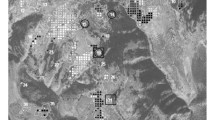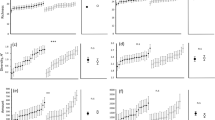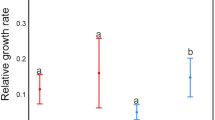Abstract
Although plant growth is generally recognized to be influenced by allocation to defense, genetic background (e.g., inbreeding), and gender, rarely have those factors been addressed collectively. In quaking aspen (Populus tremuloides Michx.), phenolic glycosides (PGs) and condensed tannins (CTs) constitute up to 30 % of leaf dry weight. To quantify the allocation cost of this chemical defense, we measured growth, defense chemistry, and individual heterozygosity (H obs at 16 microsatellite loci) for male and female trees in both controlled and natural environments. The controlled environment consisted of 12 juvenile genets grown for 3 years in a common garden, with replication. The natural environment consisted of 51 mature genets in wild populations, from which we sampled multiple ramets (trees) per genet. Concentrations of PGs and CTs were negatively correlated. PGs were uncorrelated with growth, but CT production represented a major cost. Across the range of CT levels found in wild-grown trees, growth rates varied by 2.6-fold, such that a 10 % increase in CT concentration occurred with a 38.5 % decrease in growth. H obs had a marked effect on aspen growth: for wild trees, a 10 % increase in H obs corresponded to a 12.5 % increase in growth. In wild trees, this CT effect was significant only in females, in which reproduction seems to exacerbate the cost of defense, while the H obs effect was significant only in males. Despite the lower growth rate of low-H obs trees, their higher CT levels may improve survival, which could account for the deficit of heterozygotes repeatedly found in natural aspen populations.






Similar content being viewed by others
References
Ayres MP, Clausen TP, MacLean SF Jr, Redman AM, Reichardt PB (1997) Diversity of structure and antiherbivore activity in condensed tannins. Ecology 78:1696–1712
Bangert RK, Turek RJ, Martinsen GD, Wimp GM, Bailey JK, Whitham TG (2005) Benefits of conservation of plant genetic diversity to arthropod diversity. Conserv Biol 19:379–390. doi:10.1111/j.1523-1739.2005.00450.x
Barbehenn RV, Constabel PC (2011) Tannins in plant–herbivore interactions. Phytochemistry 72:1551–1565
Barton KE, Koricheva J (2010) The ontogeny of plant defense and herbivory: characterizing general patterns using meta-analysis. Am Nat 175:481–493
Boege K, Marquis RJ (2005) Facing herbivory as you grow up: the ontogeny of resistance in plants. Trends Ecol Evol 20:441–448
Bond-Lamberty B, Wang C, Gower ST (2002) Aboveground and belowground biomass and sapwood area allometric equations for six boreal tree species of northern Manitoba. Can J For Res 32:1441–1450
Cheliak WM, Dancik BP (1982) Genic diversity of natural populations of a clone-forming tree Populus tremuloides. Can J Genet Cytol 24:611–616
Cipollini D, Heil M (2010) Costs and benefits of induced resistance to herbivores and pathogens in plants. Plant Sci Rev 5:1–25
Cole CT (2005) Allelic and population variation of microsatellite loci in aspen (Populus tremuloides). New Phytol 167:155–164. doi:10.1111/j.1469-8137.2005.01423.x
Cole CT, Anderson JE, Lindroth RL, Waller DM (2010) Rising concentrations of atmospheric CO2 have increased growth in natural stands of quaking aspen (Populus tremuloides). Glob Change Biol 16:2186–2197. doi:10.1111/j.1365-2486.2009.02103.x
Coley PD (1986) Costs and benefits of defence by tannins in a neotropical tree. Oecologica 70:352–368
Constabel CP, Lindroth RL (2010) The impact of genomics on advances in herbivore defense and secondary metabolism in Populus. In: Jansson S, Bhalerao RP, Groover AT (eds) Genetics and Genomics of Populus. Springer, New York, pp 279–305
Cornelissen TG, Fernandes GW (2001) Defence, growth and nutrient allocation in the tropical shrub Bauhinia brevipes (Leguminosae). Austral Ecol 26:246–253. doi:10.1046/j.1442-9993.2001.01109.x
Cotrufo MF, De Angelis P, Polle A (2005) Leaf litter production and decomposition in a poplar short-rotation coppice exposed to free air CO2 enrichment (POPFACE). Glob Change Biol 11:971–982. doi:10.1111/j.1365-2486.2005.00958.x
Donaldson JR, Lindroth RL (2008) Effects of variable phytochemistry and budbreak phenology on defoliation of aspen during a forest tent caterpillar outbreak. Agric For Entomol 10:399–410. doi:10.1111/j.1461-9563.2008.00392.x
Donaldson JR, Stevens T, Barnhill HR, Lindroth RL (2006) Age-related shifts in leaf chemistry of clonal aspen (Populus tremuloides). J Chem Ecol 32:1415–1429. doi:10.1007/s10886-006-9059-2
Einspahr DW (1960) Sex ratio in quaking aspen and possible sex-related characteristics. Fifth World Forestr Congress Proc 2:747–750
Ellison AM, Bank MS, Clinton BD, Colburn EA, Elliott K, Ford CR, Foster DR, Kloeppel BD, Knoepp JD, Lovett GM (2005) Loss of foundation species: consequences for the structure and dynamics of forested ecosystems. Front Ecol Environ 3:479–486
Hamberger B, Ellis M, Friedmann M, de Azevedo SC, Barbazuk B, Douglas CJ (2007) Genome-wide analyses of phenylpropanoid-related genes in Populus trichocarpa, Arabidopsis thaliana, and Oryza sativa: the Populus lignin toolbox and conservation and diversification of angiosperm gene families. Can J Bot 85:1182–1201. doi:10.1139/B07-098
Han K, Lincoln DE (1994) The evolution of carbon allocation to plant secondary metabolites: agentic analysis of cost in Diplacus aurantiacus. Evolution 48:1550–1563. doi:10.2307/2410247
Hamrick JL, Godt M (1989) Allozyme diversity in plant species. In: Brown AH, Clegg MT, Kahler A, Weir B (eds) Plant population genetics, breeding, and genetic resources. Sinauer, Sunderland
Holeski LM, Vogelzang A, Stanosz G, Lindroth RL (2009) Incidence of Venturia shoot blight in aspen (Populus tremuloides Michx.) varies with tree chemistry and genotype. Biochem Syst Ecol 37:139–145. doi:10.1016/j.bse.2009.02.003
Hwang SY, Lindroth RL (1997) Clonal variation in foliar chemistry of aspen: effects on gypsy moths and forest tent caterpillars. Oecologia 111:99–108. doi:10.2307/4221665
Jelinski DE (1993) Associations between environmental heterogeneity, heterozygosity, and growth rates of Populus tremuloides in a Cordilleran landscape. Arct Alp Res 25:183–188
Jelinski DE, Cheliak WM (1992) Genetic diversity and spatial subdivision of Populus tremuloides (Salicaceae) in a heterogeneous landscape. Am J Bot 79:728–736
Jenkins JC, Chojnacky DC, Heath LS, Birdsey RA (2004) Comprehensive database of diameter-based biomass regressions for North American tree species. United States Dept. of Agriculture Forest Service, Northeastern Research Station, General Technical Report NE-319
Jing SW, Coley PD (1990) Dioecy and herbivory: the effect of growth rate on plant defense in Acer negundo. Oikos 58:369–377. doi:10.2307/3545228
Koricheva J (2002) Meta-analysis of sources of variation in fitness costs of plant antiherbivore defenses. Ecology 83:176–190
Lindroth RL (2010) Impacts of elevated atmospheric CO2 and O3 on forests: phytochemistry, trophic interactions, and ecosystem dynamics. J Chem Ecol 36:2–21. doi:10.1007/s10886-009-9731-4
Lindroth RL, Hwang S-Y (1996) Clonal variation in foliar chemistry of quaking aspen (Populus tremuloides Michx). Biochem Syst Ecol 24:357–364
Lindroth RL, Koss PA (1996) Peservation of Salicaceae leaves for phytochemical analyses: further assessment. J Chem Ecol 22:765–771
Lindroth RL, Peterson SS (1988) Effects of plant phenols on performance of southern armyworm larvae. Oecologia 75:185–189. doi:10.2307/4218553
Lindroth RL, St. Clair SB (2013) Adaptations of quaking aspen (Populus tremuloides Michx.) for defense against herbivores. For Ecol Manag 299:14–21. doi:10.1016/j.bse.2009.02.003
Lindroth RL, Scriber JM, Hsia MTS (1988) Chemical ecology of the tiger swallowtail: mediation of host use by phenolic glycosides. Ecology 69:814–822. doi:10.2307/1941031
Lindroth RL, Kinney KK, Platz CL (1993) Responses of deciduous trees to elevated atmospheric CO2: productivity, phytochemistry, and insect performance. Ecology 74:763–777. doi:10.2307/1940804
Madritch MD, Lindroth RL (2015) Condensed tannins increase nitrogen recovery by trees following insect defoliation. New Phytol. doi:10.1111/nph.13444
Madritch M, Donaldson JR, Lindroth RL (2006) Genetic identity of Populus tremuloides litter influences decomposition and nutrient release in a mixed forest stand. Ecosystems 9:528–537. doi:10.1007/s10021-006-0008-2
Massad TJ, Fincher RM, Smilanich AM, Dyer L (2011) A quantitative evaluation of major plant defense hypotheses, nature versus nurture, and chemistry versus ants. Arthropod Plant Interact 5:125–139
Mitton JB, Grant MC (1980) Observations on the ecology and evolution of quaking aspen, Populus tremuloides, in the Colorado front range. Am J Bot 67:202–209. doi:10.2307/2442643
Mitton JB, Grant MC (1996) Genetic variation and the natural history of quaking aspen. Bioscience 46:25–31
Nichols-Orians CM, Fritz RS, Clausen TP (1993) The genetic basis for variation in the concentration of phenolic glycosides in Salix sericea: clonal variation and sex-based differences. Biochem Syst Ecol 21:535–542. doi:10.1016/0305-1978(93)90052-S
Orians CM, Lower S, Fritz RS, Roche BM (2003) The effects of plant genetic variation and soil nutrients on secondary chemistry and growth in a shrubby willow, Salix sericea: patterns and constraints on the evolution of resistance traits. Biochem Syst Ecol 31:233–247. doi:10.1016/S0305-1978(02)00144-8
Osier TL, Lindroth RL (2006) Genotype and environment determine allocation to and costs of resistance in quaking aspen. Oecologia 148:293–303. doi:10.1007/s00442-006-0373-8
Pastor J, Aber JD, Melillo JM (1983/1984) Biomass prediction using generalized allometric regressions for some northeast tree species. For Ecol Manag 7:265-274
Peterson EB, Peterson NM (1992) Ecology, management, and use of aspen and balsam poplar in the prairie provinces, Canada. Forestry Canada, Northwest Region, Northern Forestry Centre, Edmonton, Alberta. Special Report 1
Porter LJ, Hrstich LN, Chan BG (1986) The conversion of procyanidins and prodelphinidins to cyanidin and delphinidin. Phytochemistry 25:223–230
Randriamanana TR, Nybakken L, Lavola A, Aphalo PJ, Nissinen K, Julkunen-Tiitto R (2014) Sex-related differences in growth and carbon allocation to defence in Populus tremula as explained by current plant defence theories. Tree Physiol 34:471–487. doi:10.1093/treephys/tpu034
Rubert-Nason KF, Couture JJ, Major IT, Constabel CP, Lindroth RL (2015) Influence of genotype, environment, and gypsy moth herbivory on local and systemic chemical defenses in trembling aspen (Populus tremuloides). J Chem Ecol 41:651–661
Ruuhola T, Julkunen-Tiitto R (2003) Trade-off between the synthesis of salicylates and growth of micropropagated Salix pentandra. J Chem Ecol 29:1565–1588. doi:10.1023/A:1024266612585
Sakai AK, Burris TA (1985) Growth in male and female aspen clones: a twenty-five-year longitudinal study. Ecology 66:1921–1927. doi:10.2307/2937388
Sampedro L (2014) Physiological trade-offs in the complexity of pine tree defensive chemistry. Tree Physiol 34:915–918
Sampedro L, Moreira X, Zas R (2011) Costs of constitutive and herbivore-induced chemical defenses in pine trees emerge only under low nutrient availability. J Ecol 99:818–827. doi:10.2307/23028867
Schweitzer JA, Madritch MD, Bailey JK, LeRoy CJ, Fischer DG, Rehill BJ, Lindroth RL, Hagerman AE, Wooley SC, Hart SC et al (2008) From genes to ecosystems: the genetic basis of condensed tannins and their role in nutrient regulation in a Populus model system. Ecosystems 11:1005. doi:10.1007/s10021-008-9173-9
Singh T (1986) Generalizing biomass equations for the boreal forest region of west-central Canada. For Ecol Manag 17:97–107
Slavov GT, Zhelev P (2010) Salient biological features, systematics, and genetic variation of Populus. In: Jansson S, Bhalerao RP, Groover AT (eds) Genetics and Genomics of Populus. Springer, New York, pp 15–38
Stevens MT, Esser SM (2009) Growth–defense tradeoffs differ by gender in dioecious trembling aspen (Populus tremuloides). Biochem Syst Ecol 37:567–573. doi:10.1016/j.bse.2009.09.005
Stevens MT, Kruger EL, Lindroth RL (2008) Variation in tolerance to herbivory is mediated by differences in biomass allocation in aspen. Funct Ecol 22:40–47. doi:10.1111/j.1365-2435.2007.01356.x
Stevens MT, Waller DM, Lindroth RL (2007) Resistance and tolerance in Populus tremuloides: genetic variation, costs, and environmental dependency. Evol Ecol 21:829–847. doi:10.1007/s10682-006-9154-4
Strauss SY, Rudgers JA, Lau JA, Irwin RE (2002) Direct and ecological costs of resistance to herbivory. Trends Ecol Evol 17:278–285. doi:10.1016/S0169-5347(02)02483-7
Tsai CJ, Harding SA, Tschaplinski TJ, Lindroth RL, Yuan Y (2006) Genome-wide analysis of the structural genes regulating defense phenylpropanoid metabolism in Populus. New Phytol 172:47–62. doi:10.1111/j.1469-8137.2006.01798.x
Tuskan GA, Difazio S, Jansson S, Bohlmann J, Grigoriev I, Hellsten U, Putnam N, Ralph S, Rombauts S, Salamov A et al (2006) The genome of black cottonwood, Populus trichocarpa (Torr. & Gray). Science 313:1596–1604. doi:10.1126/science.1128691
Villari C, Faccoli M, Battisti A, Bonello P, Marini L (2014) Testing phenotypic trade-offs in the chemical defence strategy of Scots pine under growth-limiting field conditions. Tree Physiol 34:919–930
Acknowledgments
We thank Chris Habeck and Evy Rodne-Cole (field work), Daniel Schlatter (tree ring measurements), and numerous research assistants who micropropagated and tended the common garden trees. Heidi Barnhill, Brian Rehill, Adam Gusse, and Lisa Jordan assisted with the chemical analyses. Funding was provided by the National Science Foundation (Grants DEB-0074427, DEB-0841609, and DEB-1456592), Environmental Protection Agency, and the University of Minnesota sabbatical supplement and Morris Academic Partners programs.
Author contribution statement
CTC, MTS and RLL designed the study; MTS and CTC conducted the field and laboratory work with assistance noted in the Acknowledgements; CTC and JA performed the statistical analyses; CTC wrote the manuscript with assistance from RLL and MTS.
Author information
Authors and Affiliations
Corresponding author
Ethics declarations
Conflict of interest
The authors declare that they have no conflict of interest.
Additional information
Communicated by Frederick C. Meinzer.
Electronic supplementary material
Below is the link to the electronic supplementary material.
Rights and permissions
About this article
Cite this article
Cole, C.T., Stevens, M.T., Anderson, J.E. et al. Heterozygosity, gender, and the growth-defense trade-off in quaking aspen. Oecologia 181, 381–390 (2016). https://doi.org/10.1007/s00442-016-3577-6
Received:
Accepted:
Published:
Issue Date:
DOI: https://doi.org/10.1007/s00442-016-3577-6




